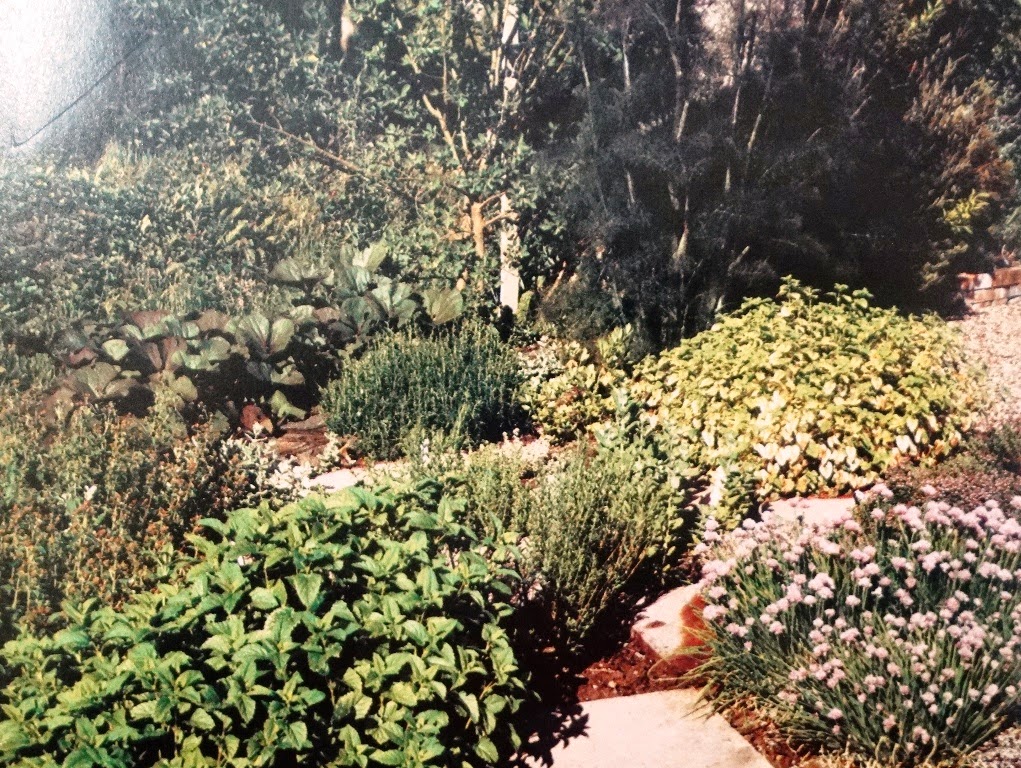Of course, one of the outstanding
characteristics of herbs is what might be termed their nasal quality. The
perfumes and aromas exuded by their leaves and flowers on a warm sunny day give
and garden a fourth dimension, and one of the charms of the Greek and Italian
hillsides is the pungently aromatic fragrance given off by the herbs and
shrubs. Some herbs have scented flowers which can be smelt before the plant is
seen; the apothecary’s rose, Rosa gallica officinalis, is an example. Others
such as rosemary (Rosmarinus officinalis) have leaves with a strong, sneeze
inducing odour; yet others have flowers or leaves which need to be rubbed in
the fingers before the aroma can be enjoyed such as lavender (Lavandula angustifolia),
or ginger mint (Mentha x gentilis variegate).
 |
| Culinary herb garden with bronze fennel, rosemary, tarragon and chives among other plants. Throughout the ages the most extensive use of herbs has been in cooking and for flavoring food. |
Moreover perfumery is probably an
even more ancient art than dyeing; it is a more obvious constituent of a plant
so would have been experimented with earlier to disguise bad smells if nothing else,
such as those of rotting meat and decaying vegetation. Fresh flowers are fine
for scenting the air but their life is finite, and to preserve their perfume,
it was found that a mixture of flower petals, collected when they were at
exactly the right stage in their development, then carefully dried or
part-dried and mixed with an ingredient which fixed the perfume, such as orris
root (Iris germanica florentina) would continue to give off fragrance for
months and even years. Such a mixture we now know as potpourri, from the French
potpourri to rot, not a very accurate name, since the ingredients are preserved
rather than allowed to decay.
Eventually there can be discovery
that scented oil could be extracted from those flowers or leaves which were
perfumed. Enfleurage is one method of doing this, by making a kind of sandwich
with purified fat forming the “bread” and the flower petals the contents of the
sandwich. Distillation is another in which flowers are boiled in water, and the
essential oil given off in the steam is collected and condensed by cooling.
Extraction with alcohol is a third method, when the solvent trickles over the
plant material is collected and then distilled to leave the oil as a solid
material. Fragrant herbs playa great part
in what has come to be called aromatherapy, in which essential fragrant oils
from herbs are rubbed on to the skin. The different fragrances are thought to
have an improving effect on a variety of physical and emotional problems.
Now that herbs have invaded
several parts of our lives, and not least our gardens how much of this is just
a fashionable phase, and how much will remain as a permanent and essential
ingredient of everyday living? Since herbs do so much for the flavor of food
and its digestion, have such profound use in medicine, both for humans and
animals, and have so much utilitarian value domestically in the home, and in
the garden, it seems most unlikely that they will ever fall into such disuse
again. The countries of the Third World in particular need them desperately for
medical purposes, as the synthesized drugs are so expensive. Another pointer to
their continued and increasing use is the recent interest in holistic medicine;
the philosophy of which can have such far reaching effects that the entire way
of life of modern civilization may be completely altered by the time the twenty
first century is going on.
 |
|
· It was once thought that
plants that looked like the symptoms of an illness could be used to cure it.
Lungwort, for example was recommended for lung conditions because people
believed its white spotted leaves bore a resemblance to diseased lungs. Source: Charismatic Planet
|










